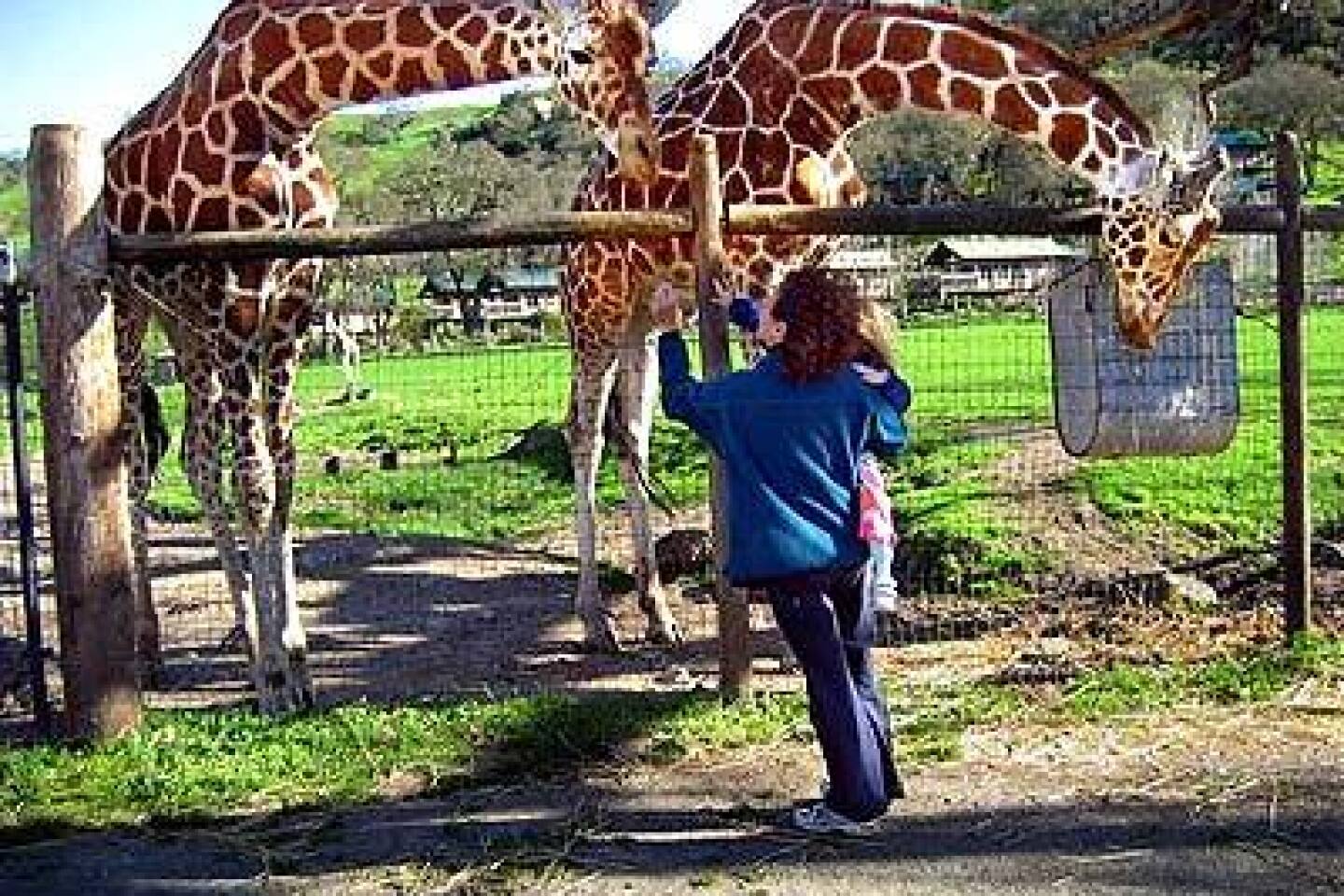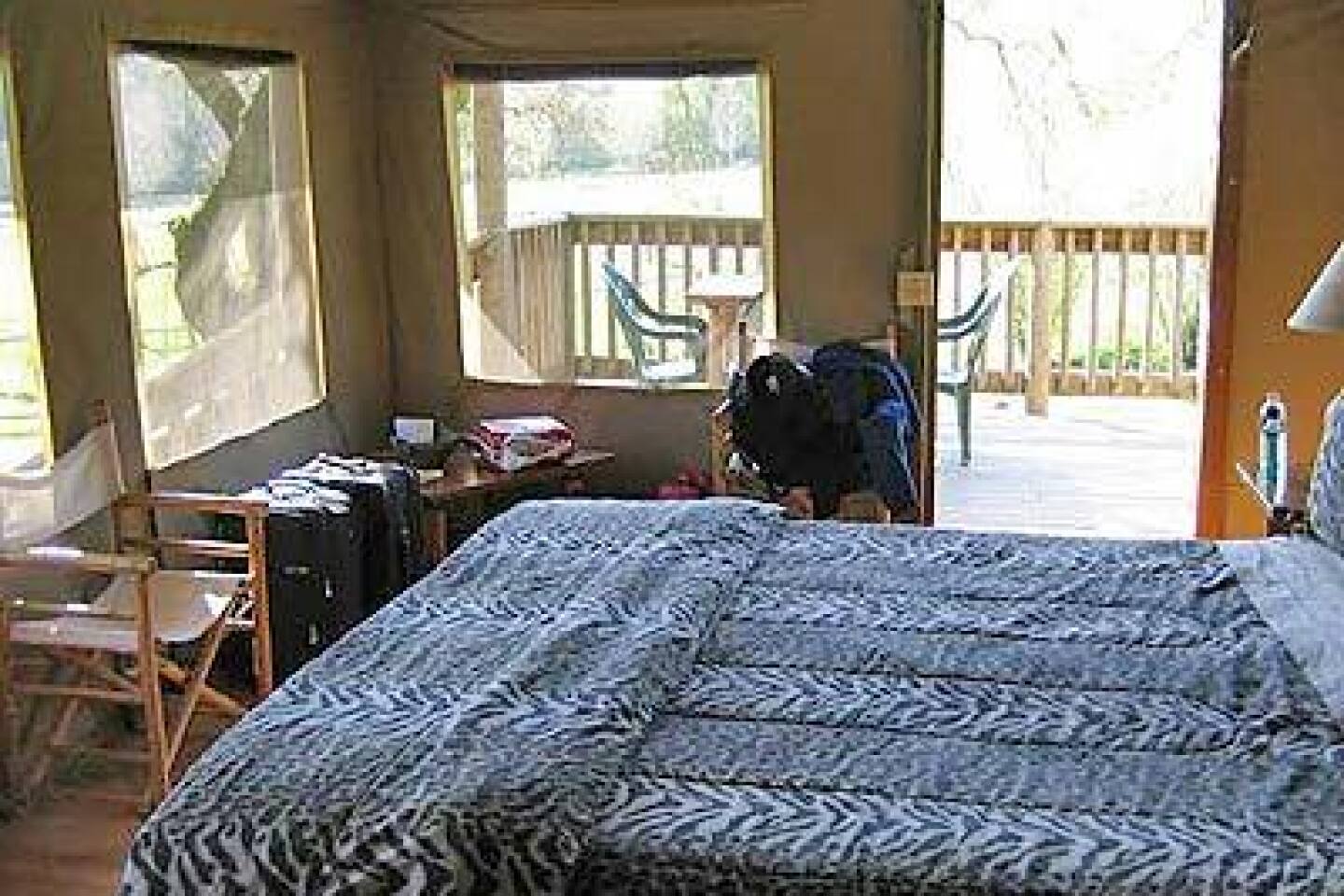In wine country, savoring a hint of Africa
- Share via
One of life’s great pleasures, it turns out, is watching from the front porch as baby giraffes gambol through lush pasture.
Safari West, a 400-acre spread in Santa Rosa, might be the only spot on this continent where I could have discovered this particular joy. It’s the only African animal preserve in the U.S. with a tent camp where you can be lulled to sleep by the calls of ring-tailed lemurs.
It’s a world apart from the experience most of us have with African wildlife. At the Los Angeles Zoo, you are lucky to be one of a small crowd separated from animals by moats, protective plexiglass and chain-link fences. Even at the much-bigger San Diego Wild Animal Park, most sightings are done from a monorail. Here, in the Sonoma Valley, I felt for the first time the grassy breath of a giraffe on my face.
On a weekend in mid-March, my husband, daughter and I snagged cheap airline tickets to Oakland, about a 90-minute drive from Santa Rosa. We arrived in time for a Saturday afternoon tour.
Some visitors come just for the day to go on one of the three-hour safari tours that take 10 or 12 people in an oversized jeep. I was concerned the ride might be a long haul for our 3-year-old daughter. Recent rains had rutted the dirt road, making it bone-jarringly bumpy in spots, but this prompted only squeals of delight from the young set.
The guide driving our jeep offered an overview and zoological trivia about the animals. I learned, for instance, that a giraffe’s tongue is about 18 inches long. Zebras will kill an injured member of their herd and run off rather than risk attracting a predator. And the Cape buffalo is Africa’s most dangerous animal.
Our guide, Erin Earnshaw, dished out the skinny on the animals’ intimate secrets too. Stella, one of the odd red-skulled saurus cranes, was raised by humans and thus has a thing for grown men. Phillip, another saurus crane, finds that terribly perplexing.
At Safari West, most animals run free in large, fenced fields. While Erin hopped out to open a gate, a female ostrich was quite drawn to our jeep. To be more specific, the ostrich seemed drawn to me.
The 320-pound bird popped up by my side. Gently, she plucked first at my jacket and then at my hand. With large dark eyes, she peered into my face. When the jeep pulled away, she followed. Clearly, I was eye candy for this ostrich. Later, I learned about my resemblance to a former animal keeper.
Africa connections
Safari West was founded in 1979 by Peter Lang, whose father, Otto, directed animal-themed movies and TV shows, including “Daktari,” “Flipper” and “Sea Hunt.”Peter Lang grew up in Southern California surrounded by animals and as an adult began collecting and breeding them, starting with antelopes. As his menagerie grew, he needed more acreage, and moved from Beverly Hills to Santa Rosa to find it.
Lang and his wife, Nancy, a former curator at the San Francisco Zoo, traveled frequently in Africa during the ‘80s and ‘90s. In building Safari West, she said in an interview after my visit, they hoped to re-create that experience for guests. Safari West, she said, not only propagates rare animals in California, but also spreads attitudes that might help safeguard them everywhere.
Safari West is home to 29 species of mammals. Some, like the cheetah, addax and scimitar-horned oryx, are endangered or classified as “extinct in the wild.” The animals roam freely in large enclosures, so visitors are unlikely to see all of them. We circled unsuccessfully searching for a herd of Watusi cattle. It didn’t matter. Instead, we came upon a herd of grazing zebras. And the hillsides, after a winter of heavy rains, were magnificently green and exploding with wildflowers.
We did come upon the deadly Cape buffalo, which is known to charge and kill hunters in Africa. There are only 28 in North America, five of those at Safari West. Despite comically upturned horns — sort of a buffalo flip — each had a serious, steady gaze and 2,000 pounds to back it up. They regarded our jeep with casual interest and, fortunately, took us as no threat.
Finishing our safari, we passed the corral of Bender, the white rhinoceros who earns that name by denting everything in sight with his horn, including his super-size food and water bowls. Later this spring, Safari West is to open a new 12-acre oak savanna habitat for the 5,600-pound rhino, as well as giraffes, gazelles, kudus, scimitar-horned oryxes, nyalas and springbok.
Back at the dining hall, everyone (except for one excited 3-year-old) was ready for a short break with tea, coffee and lemonade. The final leg of the tour is a short stroll of the grounds to view animals in smaller pens, such as the fennec fox, and inside the netted aviary, which houses the kookaburra, which doesn’t chirp so much as laugh, and the aptly named hammerkop, also called the hammerhead. Both paled next to the brilliant scarlet ibis. Inside the aviary, we also saw the blue duiker, an antelope no bigger than a terrier.
Tent cabins, no TV
As the sun set, some guests filed into the dining hall where Safari West serves a restaurant-style dinner. As an economy measure, we chose a picnic on the porch of our tent cabin.We were hardly roughing it. Ours was one of the 30 spacious tent cabins — wood frames with canvas walls and netted windows — for overnight stays. Rooms have a king or two double beds, and a private bathroom with regular plumbing, including a shower. True, there was no TV, no Ethernet port, no phone — even cellphone access is iffy. Instead of a mini-fridge, we had a cooler with ice. The front porch overlooked a field of giraffes, red lechwe antelopes and East African crown cranes, long-legged birds that look as if they escaped the pages of a Dr. Seuss book.
Nestled beneath an oak, our cabin felt like a luxurious treehouse. It was more fun than any hotel room and seemed to promise adventure. In addition to having an interest in animals, Peter Lang also designs and builds wood furniture, including many of the pieces in the tent cabins. Everything required exploration by our daughter.
As soon as the sun went down, the cabin became chilly, and we flipped on our one heater. When we went to sleep, we switched on the electric blanket and reluctantly Velcroed shut several windows. Despite the canvas flapping in an usually strong wind and the deep, booming calls of the ostrich, it was a remarkably peaceful night.
After a satisfying breakfast, included with lodging, of oatmeal, blueberry muffins and fruit salad, we ambled from one animal habitat to another. It seemed to be a particularly good time of day for animal-watching. The previous afternoon, we’d seen cheetahs from a distance. But in the morning, the pair was being groomed right next to the fence — close enough we could count their whiskers. We also got a good look at the Indian crested porcupines, Norton and Prickers, and their baby Malo, as they gobbled their meal.
It was, however, the giraffes that stole our hearts.
As we stood outside their field, two gentle males sauntered over and one slowly lowered his head over the fence toward us. It’s difficult to comprehend how large a giraffe is until you are face to face. A giraffe’s head is huge. Then he stuck out a blue tongue.
My daughter understood immediately. “Mom,” she said, “give him some grass.” So we did.
Acres of wildlife in Santa Rosa
Expenses for three on this trip:
Lodging
One night at Safari West with tax: $194
Meals
Picnic supplies and other meals: $70
Entertainment
Safari West tours for two adults and one child: $144
Transportation
Airfare from Burbank to Oakland and rental car:
$359
Total $767
Distance from L.A. 441 miles
WHERE TO STAY:
Tent Camp, Safari West, 3115 Porter Creek Road, Santa Rosa; (707) 579-2551, https://www.safariwest.com . Tent cabins for two people cost $225 per night in high season; add $25 for each additional guest. Two-night minimum stay on weekends May to September. One two-bedroom cottage, for four guests, is $300 per night.
WHAT TO DO:
Safari Tours, see information above. Three-hour jeep and walking tour led by a naturalist through the 400-acre preserve. Groups of 10 to 12 depart at 9 a.m. and 1 and 4 p.m. daily. Adults $58, $28 children.
More to Read
Sign up for Essential California
The most important California stories and recommendations in your inbox every morning.
You may occasionally receive promotional content from the Los Angeles Times.
















